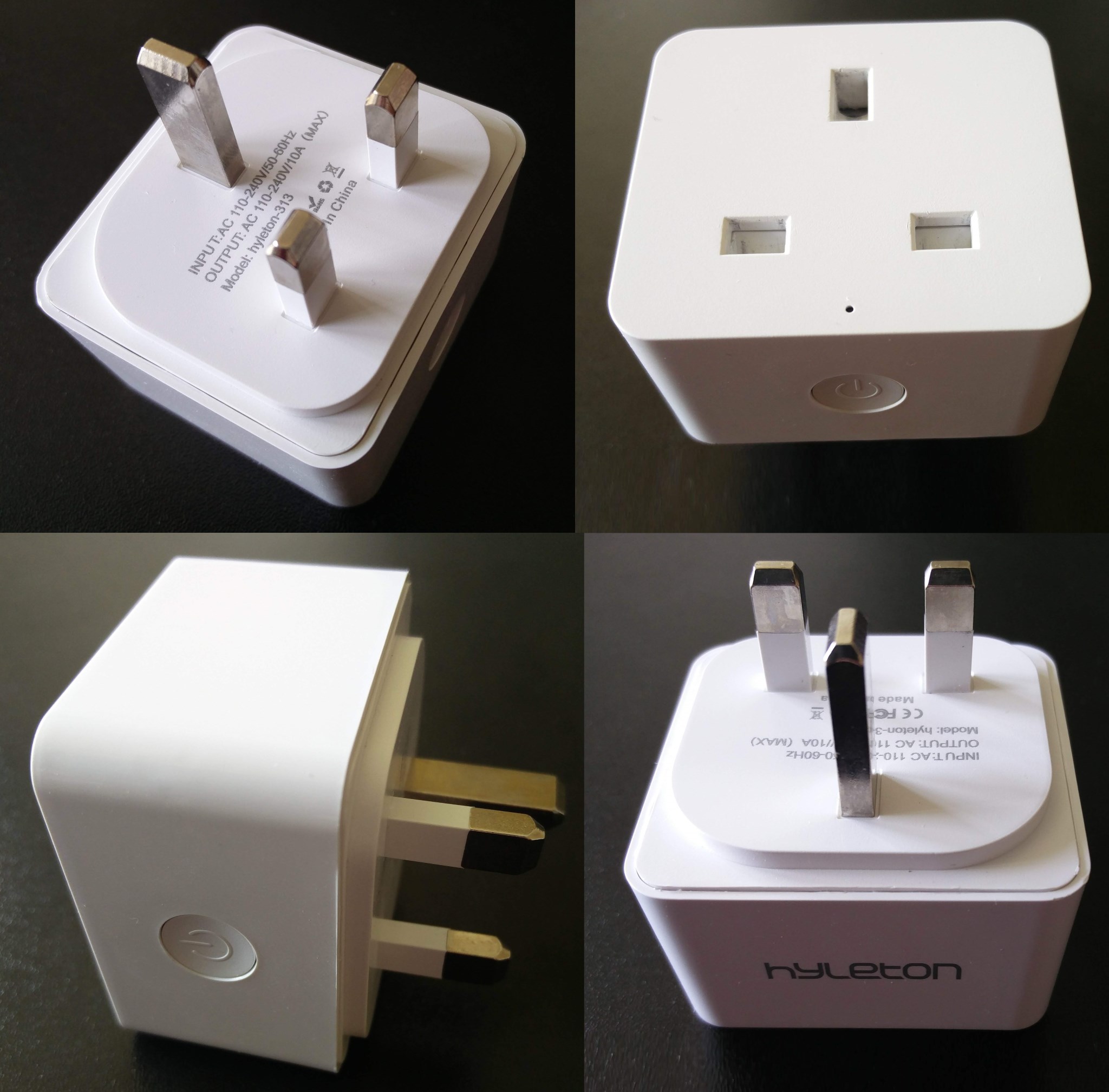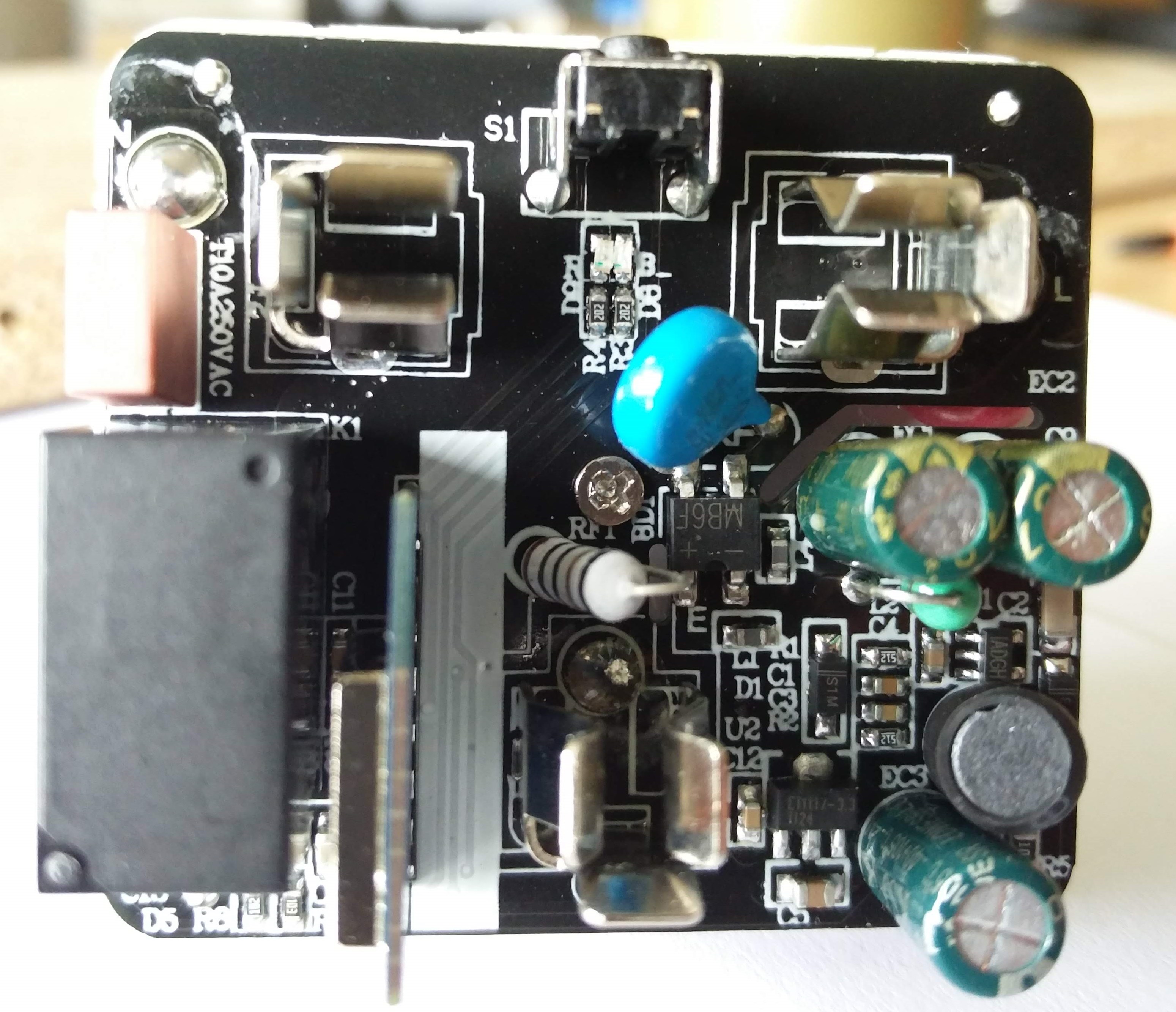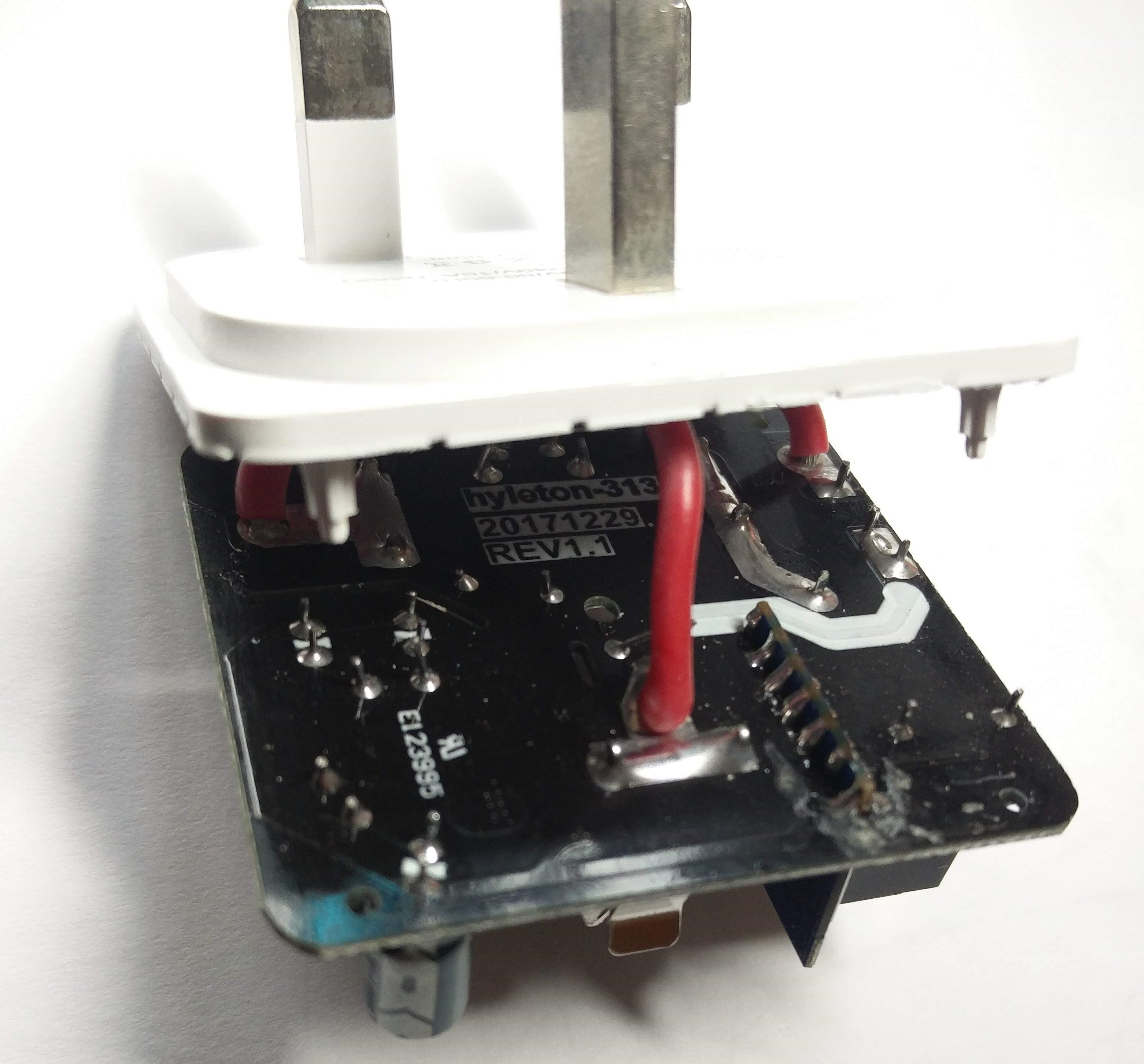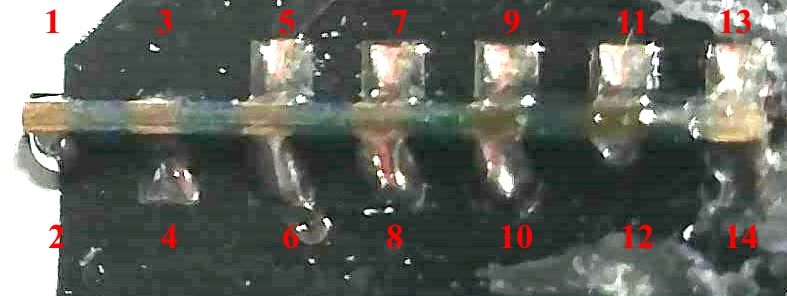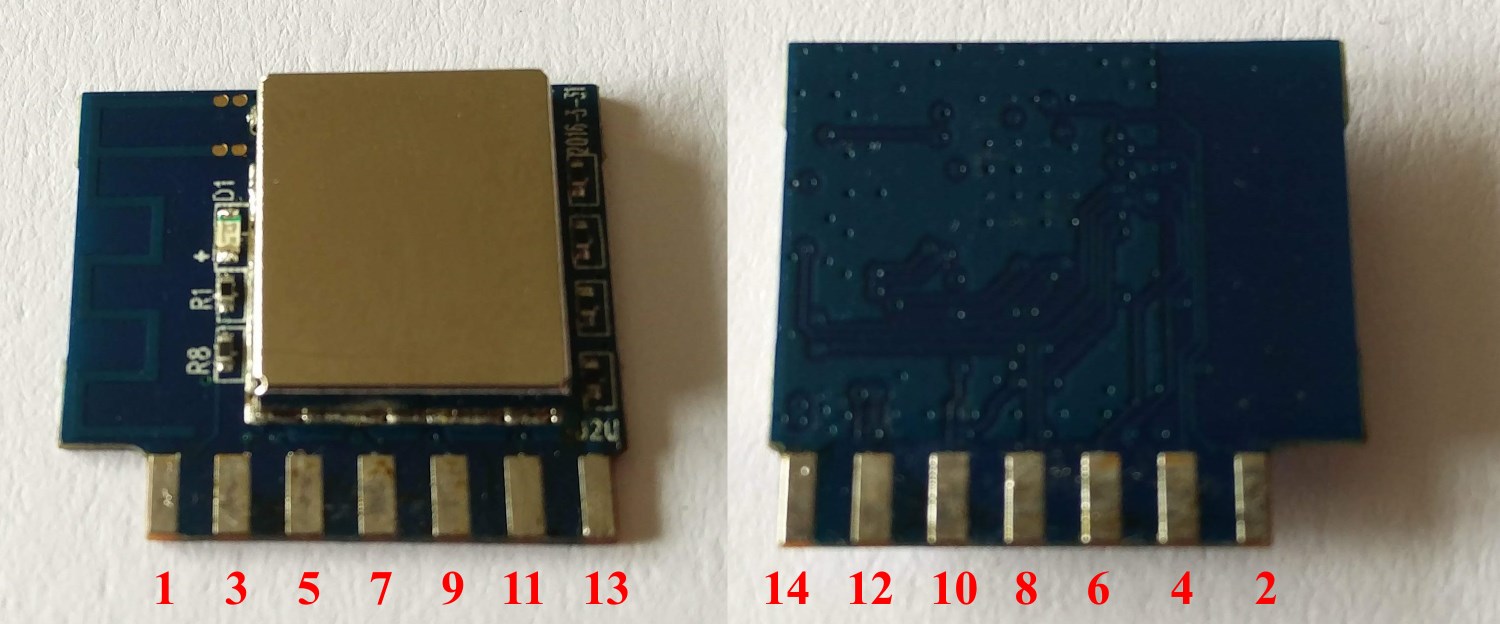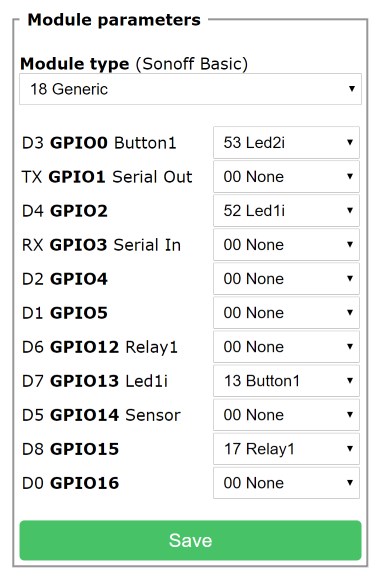-
Notifications
You must be signed in to change notification settings - Fork 1
Hyleton 313 Smart Plug
Recently I bought a very nice and compact Smart Plug (UK variant) from Aliexpress - a Hyleton 313. This was in fact the smallest smart plug device with UK plug I've ever seen - it is no bigger than an average USB/phone charger:
Another good thing is that it is built around a ESP8266 module, which gives us the possibility to change its firmware and install Tasmota.
There are no visible screws, however it is not that difficult to open the case using some sharp plastic pry tool and a heat gun (hair dryer on max setting will probably also work). Heat the edge of the plug a bit, then work your way slowly, pry from the middle of each side. Then slowly slide the tool towards the corners and the case will ease enough eventually - open it with a gentle pull.
Once the case is open, the top side of the PCB will be exposed:
The WiFi module is soldered vertically to the main PCB and sits right next to the relay. In order to get access to its pins, remove the screw from the centre of the PCB. After that the bottom plastic plate, which holds the three mains connector prongs, can be moved a bit to the side without desoldering anything (it is attached with short cables to the PCB, but cables' length is just enough to move it out of the way of the WiFi module's pins).
Here's a view of the bottom side of the PCB:
You can see the product labels (product code, date and board revision), as well as the UL number.
Here is a close-up view of the module's pins as seen from the bottom of the main PCB:
And this is how module pins numbers are mapped (I had to desolder the module looking for labels when I tried to identify it):
Failed to identify the module, I had remove the metal shielding cap to find the routing of the ESP8266's pins, so I grabbed the multimeter and soon I had the following table:
| Module pin | ESP8266 pin | Pin name | Pin name | ESP8266 pin | Module pin | |
|---|---|---|---|---|---|---|
| 1 | 7 | Chip Enable | Tout (ADC) | 6 | 2 | |
| 3 | 9 | MTMS / GPIO14 | MTDI / GPIO12 | 10 | 4 | |
| 5 | 12 | MTCK / GPIO13 | MTDO / GPIO15 | 13 | 6 | |
| 7 | 15 | GPIO0 | GPIO2 | 14 | 8 | |
| 9 | 16 | GPIO4 | GPIO5 | 24 | 10 | |
| 11 | 25 | U0RXD | U0TXD | 26 | 12 | |
| 13 | Vdd | - | - | GND | 14 |
For programming you need to solder 4 jumper wires to pins 11, 12, 13 and 14 (Rx, Tx, Vdd and GND). Connect the other end of the wires to your USB-to-serial adapter and make sure the supply voltage selected is 3.3V. Shorting pin 7 (GPIO0) to ground while plugging the serial adapter into the computer's USB port will bring the module into UART firmware upload mode.
Once Sonoff-Tasmota's WebUI configuration interface is loaded in the browser, you can change many settings using the menu options. Console window is where you can change almost all configuration parameters.
Head straight to the Configure Module menu, selected 'Generic' for 'Module type'. Here are the settings that I selected on that screen:
Sonoff devices usually have a bi-colour LED, but just one of the colours can be controlled directly. The other colour is usually tied together with the relay, so it cannot be controlled independently. I think that is the reason why the Sonoff-Tasmota firmware by default controls just Led1 when a single relay is configured. In the configuration above, only the blue LED will be used (tied to GPIO2). But if you prefer the red LED, just change the values for Led1i and Led2i (select Led1i for GPIO0 and Led2i for GPIO2).
If you want to read the detailed project log, you can do so on my GitHub Blog page.
Home | Wiki | What's new | Tutorials | FAQ | Troubleshooting | Button usage | Commands | Rules
Home
Theo's Tasmota Tips
What's New
Getting Started
Upload tools
- SonOTA
- OTA over SCP
- Esptool
- Arduino IDE
- PlatformIO
- PlatformIO CLI
- Visual Studio Code
- Python HTTP OTA server
- Node Red OTA server and firmware manager
Usage
- Button Functionality
- MQTT Features
- Supported Commands
- Using Rules
- Sensor Configuration
- PowerOnState Configuration
- SwitchMode/SwitchTopic
- Button Multipress
- Energy Saving
- KNX Features
- Misc. Tips
Devices - Additional Info
- Sonoff Basic
- Sonoff SV
- Sonoff S20 Smart Socket
- Sonoff S26 Smart Socket
- Sonoff Dual / Dual R2
- Sonoff 4CH / 4CH Pro
- Sonoff RF and Slampher
- Sonoff RF Bridge 433
- Sonoff Pow / Pow R2
- Sonoff Touch
- Sonoff T1
- Sonoff B1 / B1 R2
- Sonoff iFan02
- Sonoff SC
- Sonoff PSA
- Sonoff S31
- Shelly 1 and 2
- Wemos D1 R1 & R2
- Wemos D1 Mini
- HuaFan Smart Socket
- Hyleton-313 Smart Plug
- MagicHome LED controller
- H801
- Arilux LC02
- SP108E LED controller
- Blitzwolf SHP2
- Tuya Dimmer
- PS-16-DZ Dimmer
- Armtronix Dimmers
- Other Devices
- retired
Home Automation Integration
- OpenHAB
- Home Assistant
- Domoticz - Manual configuaration
- Domoticz - Automatic discovery
- HomeBridge
- HomeSeer
- SmartThings
- IP-Symcon
- IOBroker
- TasmoAdmin
- Alexa
- Yeti
- NodeRed Examples
- Securing your Setup
Other Integrations
Further Topics
- MQTT Overview
- Remote Button
- Modified Kaku
- PZEM004T Energy Monitor
- IR Extension
- S20 sensor
- Wiring additional things to a module
- Sonoff Basic DHT11 Wiring
- Expand Sonoff 4CH with jack plug
- Defining new module types
- GPIO Locations
- JSON Status Responses
- Expand Sonoff Basic to 4MB Flash
- Time Proportioned Output support
- PID Control with Sonoff Devices
- Sensor-API
- Sensors Supported by Tasmota
- Syslog Setup
ESP32
Misc
